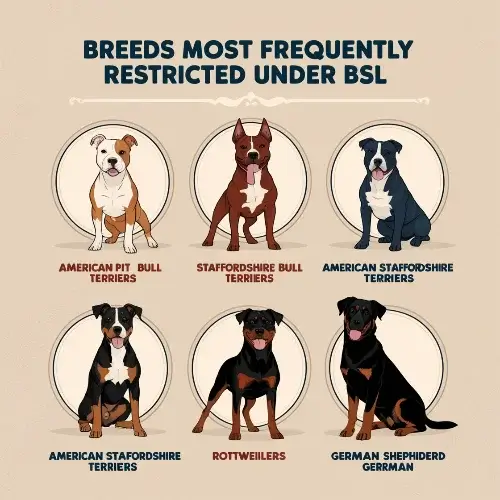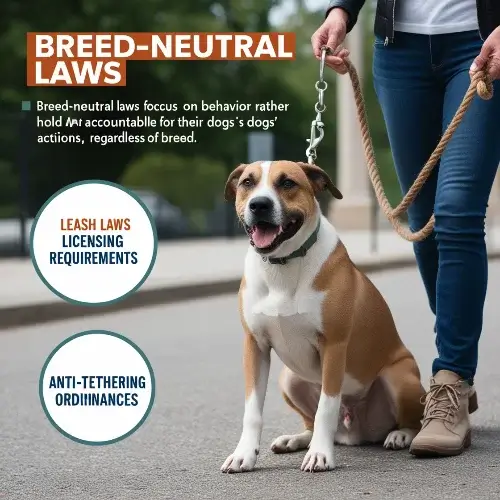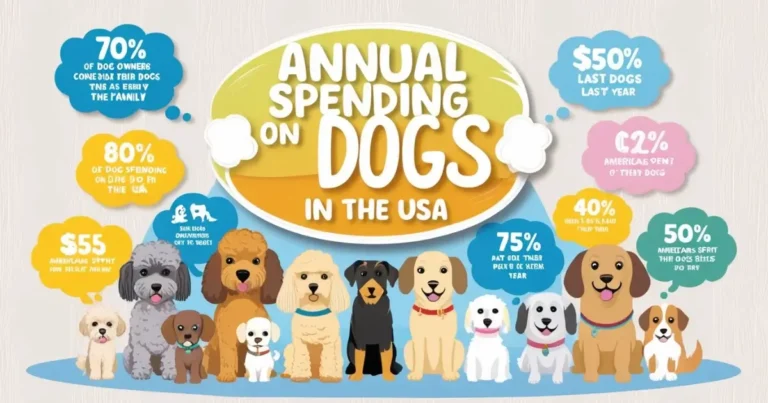Breed-Specific Legislation and Its Impact on Dog Populations
Breed-specific legislation (BSL) is a set of laws targeting specific dog breeds considered dangerous. These regulations aim to protect public safety but often raise concerns about fairness, effectiveness, and impact on dogs and their owners. This article explores BSL, its controversies, and effective alternatives for addressing dog aggression.
Table of Contents
Understanding Breed-Specific Legislation (BSL)
Definition and Purpose of BSL
Breed-specific legislation bans or restricts certain breeds to reduce dog attacks. It was introduced as a preventive measure against rising incidents of dog bites. Lawmakers believed focusing on specific breeds would create safer communities.
However, BSL overlooks individual dog behavior and relies solely on appearance. This creates ineffective laws that fail to address the real causes of aggression.
Breeds Most Commonly Targeted
The breeds most frequently restricted under BSL include:
- American Pit Bull Terriers
- Staffordshire Bull Terriers
- American Staffordshire Terriers
- Rottweilers
- German Shepherds

These dogs are often labeled aggressive based on physical characteristics rather than behavior. Misidentification of mixed breeds further complicates enforcement.
Global Implementation of Breed-Specific Laws
Globally, breed-specific laws worldwide vary widely. In the United States, over 700 cities enforce BSL, but states like Texas and Illinois prohibit such laws. Canada has similar inconsistencies, with Ontario banning pit bulls while other provinces implement breed-neutral policies.
In Europe, Germany bans specific breeds, while Switzerland evaluates dogs individually. These variations highlight the lack of a standardized approach to regulating potentially aggressive dogs.
Controversy Surrounding Breed-Specific Legislation
Misconceptions About Dog Behavior
Many believe aggression is tied to breed, but research shows otherwise. Dogs are more likely to bite due to factors like poor training, neglect, or lack of socialization. Any dog, regardless of breed, can become dangerous under such circumstances.
Focusing on specific breeds distracts from the real issue: irresponsible ownership. A well-trained pit bull is less of a threat than an unsupervised or neglected small dog.
Challenges in Enforcing BSL
Enforcing BSL is challenging due to breed misidentification. Animal control officers often rely on physical features to classify dogs, leading to errors. For example, a Labrador mix might be mistaken for a pit bull.
These errors result in unfair penalties for responsible owners and stress for dogs that pose no threat. This inconsistency undermines the effectiveness of BSL.
Ethical and Social Implications
The controversy over breed-specific legislation extends to its ethical impact. Families may be forced to give up beloved pets based on breed alone. Many banned breeds are euthanized in shelters, even if they are healthy and well-behaved.
BSL disproportionately affects responsible owners while neglecting to address truly dangerous dogs. It also stigmatizes breeds that serve as service animals, therapy dogs, or rescue dogs.
Statistics and Effects of Breed Bans on Dog Populations
Banned Dog Breeds Statistics
Studies often highlight breeds like pit bulls in dog bite incidents. From 2005 to 2019, pit bulls accounted for 284 fatalities in the U.S. However, these banned dog breeds statistics fail to account for factors like population size or reporting biases.
Statistics also exclude critical context, such as whether the dog was provoked or neglected. This makes it difficult to draw meaningful conclusions about breed-specific aggression.
Impacts on Shelter and Rescue Organizations
BSL increases the burden on shelters. Dogs from banned breeds are often abandoned, leading to higher euthanasia rates. Adoptions decline because families fear legal repercussions.
This results in overcrowded shelters and wasted resources. Instead of helping dogs find homes, BSL forces shelters to euthanize adoptable animals.
Economic Costs of Enforcing BSL
Enforcing BSL is expensive. Municipalities spend significant funds on breed identification, legal cases, and public education campaigns. These efforts often fail to reduce dog bites.
Redirecting these resources to training programs or community outreach would be more effective. BSL’s financial burden outweighs its benefits, making it an inefficient policy.
Effective Alternatives to Breed-Specific Legislation
Promoting Responsible Pet Ownership
Encouraging responsible ownership is a better solution than banning specific breeds. Key practices include:
- Proper training and socialization
- Early neutering or spaying
- Educating owners about dog behavior
Community workshops and school programs can raise awareness about preventing dog aggression. These initiatives empower owners to raise safe, well-behaved pets.
Breed-Neutral Laws
Breed-neutral laws focus on behavior rather than appearance. They hold owners accountable for their dogs’ actions, regardless of breed. Effective measures include:
- Leash laws
- Licensing requirements
- Anti-tethering ordinances
These laws address the root causes of aggression without unfairly targeting specific breeds.

Community-Based Solutions
Collaboration between local governments, veterinarians, and animal welfare groups can improve public safety. Programs like low-cost spay/neuter clinics and affordable training classes help reduce risks.
Community-based solutions emphasize prevention, tackling the problem at its source. These approaches are humane, effective, and cost-efficient.
BSL vs. Breed-Neutral Laws
| Feature | Breed-Specific Legislation | Breed-Neutral Laws |
| Focus | Specific breeds | Behavior and owner responsibility |
| Enforcement | Difficult (breed misidentification) | Clear and consistent |
| Public Safety Impact | Minimal | Significant |
| Effectiveness | Poor | Proven |
| Ethical Concerns | High (discrimination) | Low |
Conclusion: Rethinking Dog Legislation
Breed-specific legislation fails to address the real causes of dog aggression. It unfairly targets breeds, burdens shelters, and wastes public funds.
A shift towards responsible pet ownership, breed-neutral laws, and community-based solutions is the way forward. These approaches protect public safety while ensuring fairness for all dogs and their owners.
By adopting inclusive and effective policies, we can create safer, more compassionate communities.
FAQs
Are breed-specific laws the same worldwide?
No, breed-specific laws worldwide differ significantly. Some U.S. states ban BSL, while others enforce it. Canada’s provinces vary, and in Europe, some countries focus on individual dog behavior rather than breed bans. These inconsistencies highlight the lack of a universal approach.
Why is there controversy over breed-specific legislation?
The controversy over breed-specific legislation arises from its reliance on stereotypes rather than evidence. BSL unfairly targets certain breeds, overlooks owner responsibility, and leads to higher shelter euthanasia rates without effectively reducing dog bites.
What are the effects of breed bans on dog populations?
The effects of breed bans on dog populations include increased euthanasia rates for restricted breeds and reduced adoption rates. These laws place a strain on shelters, divert resources, and fail to address the root causes of dog aggression.
What alternatives exist to breed-specific legislation?
Alternatives to breed-specific legislation include breed-neutral laws focusing on behavior, leash laws, and community education. These solutions hold owners accountable, promote responsible pet ownership, and address aggression without penalizing specific breeds.







